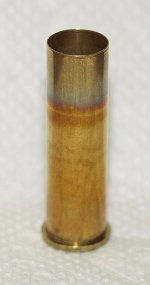A little crimp on my 357 case goes a long ways.
I set my die to a taper crimp and a "touch" more for my light
lead practice loads whit the screw pin sticking 1.27" above my
locking screw on the die.
For a medium crimp on lead or all my Jacketed bullets the pin
is set to 1.265"
My heavy lead setting is set at just 1.26" above the locking screw.
As you can see, with my dies, a little goes a long ways......
and yes the heavy crimp on the deep LSWC cannelure can be
a bummer, if you need to pull this style bullet.
I have broken one inertia bullet puller.
From now on I usually just shoot the mistake or bad round unless you can't live with it.
I set my die to a taper crimp and a "touch" more for my light
lead practice loads whit the screw pin sticking 1.27" above my
locking screw on the die.
For a medium crimp on lead or all my Jacketed bullets the pin
is set to 1.265"
My heavy lead setting is set at just 1.26" above the locking screw.
As you can see, with my dies, a little goes a long ways......
and yes the heavy crimp on the deep LSWC cannelure can be
a bummer, if you need to pull this style bullet.
I have broken one inertia bullet puller.
From now on I usually just shoot the mistake or bad round unless you can't live with it.

